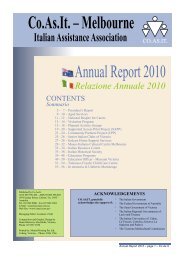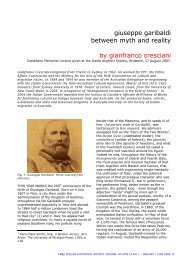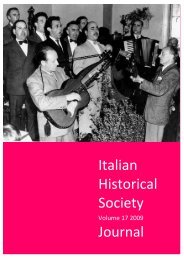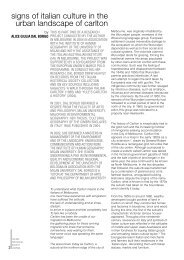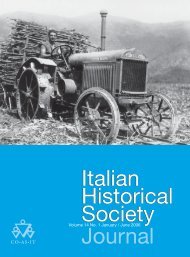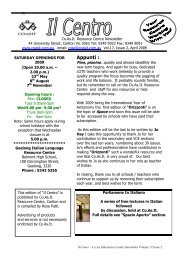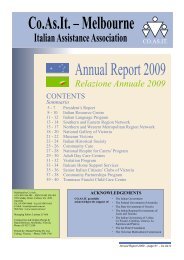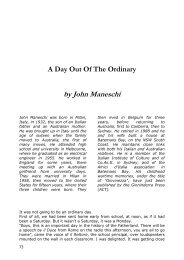January-December 2010, vol. 1
January-December 2010, vol. 1
January-December 2010, vol. 1
- No tags were found...
You also want an ePaper? Increase the reach of your titles
YUMPU automatically turns print PDFs into web optimized ePapers that Google loves.
Two other key figures, represented in Australian collections byfour short films are Emanuele Luzzati and Giulio Gianini. Luzzati,an art director and artist from Genoa, together with animatorGiulio Gianini, authored a series of brilliant colour animationsabout traditional characters and tales in Italian popular cultureand music. They won the prize for best short at the 1965Melbourne Film Festival with La gazza ladra (The ThievingMagpie) (Luzzati and Gianini, 1964) which was later nominatedfor an Oscar. Their other 16mm shorts in Australian film librariesare L’Italiana in Algeri (Luzzati and Gianini, 1968) only availableat the State Library of NSW in Sydney; Ali Baba (Luzzati andGianini, 1970) available in Sydney, Melbourne and Perth; andPulcinella (Luzzati and Gianini, 1973), which received an Oscarnomination and is available both in the ACMI film library andthe State Library of NSW. Luzzati and Gianini’s work is strikingfor its audio-visual qualities. The brighter-than-life colours andthe music-driven animation produce a sensorial feast thatcomes as quite a contrast with the standard commentarydriven English-speaking documentary available in the libraries.Little more is worth mention amongst the available Italianproduceddocumentaries. There are three documentariesabout Italian cinema investigating De Sica, Neorealism andBernardo Bertolucci while shooting 1900 (1976) and moreentries from the art world: Chiostri e cortili (1941) a blanddocument on Roman classic architecture in Italian withoutsubtitles; La <strong>vol</strong>ta della Sistina (produced by Lux Films in 1947) awordless visual study of Michelangelo’s work by Pietro Francisciwho later directed many of the “sword and sandal” films. Otherfour Lux Films productions in the SFC library are MonetaRomana (Pellegrini 1949), in Italian without subtitles;L’esperienza del cubismo (Pellegrini 1949) with script byscreenwriter Rodolfo Sonego; Una lezione di anatomia(Pellegrini 1950) again with text by Sonego and Una lezione diGeometria (Sabel and Sinisgalli 1958). Founded in Turin in 1934,Lux Films was at the time one of the largest Italian productioncompanies investing in quality Italian cinema anddocumentary. 23 Both documentarists, Glauco Pellegrini andRodolfo Sonego, later worked together on the Lux featureOmbre sul Canal Grande (1951).The situation regarding Italian feature length films in the statecollections is more difficult to ascertain. There are no signs of anItalian feature film in the libraries before the arrival of a 16mmcopy of Bicycle Thieves (De Sica, 1948) in 1970. The sevenfeatures currently available in 16mm represent too small andtoo scattered a sample to identify a meaningful trend. 24 Worthnoting is the late presence of three Rossellini films: Roma, città23 Alberto Farassino and Tatti Sanguineti, “Lux Film: esthétique etsystème d'un studio italien” (Locarno : Editions du Festival internationaldu film de Locarno, 1984), p.7124 Ladri di biciclette (De Sica 1948, Italian with English subtitles); Roma,città aperta (Rossellini 1945, Italian with English subtitles, ‘educationaluse only’); Viaggio in Italia (Rossellini 1954, English language); I solitiignoti (Monicelli 1958, English language); Atti degli Apostoli (Rossellini1969, English language); La caduta degli Dei (Visconti 1969, Englishlanguage); Libera amore mio (Bolognini 1973, Italian language).aperta (1945) part of the educational collection; Viaggio in Italia(1954) with original English language soundtrack; and Atti degliApostoli (1968) dubbed into English, a credit to the importanceof Rossellini in introducing a different idea of realism to theAustralian spectator.However, 16mm copies of some Italian feature films wereavailable for borrowing from the Australian National FilmLibrary (NFL) in Canberra. The films at the federal library couldbe booked and borrowed through the local state film librariesoffices. The National Film Library was established at the sametime as the state libraries but had a stronger interest in featurefilms and for a long time performed the function of a NationalCinémathèque, employing the 16mm format. The NFL was partof the National Library of Australia and became the NonTheatrical Loans Collection (NTLC) of the National Film andSound Archive (NFSA) after its creation in 1984. Today theCanberra 16mm collection holds 42 feature films out of 82Italian produced films. They are part of a 16mm collection with9,778 16mm copies (out of a total of 19,840 copies in variousformats). A recent survey in collection digital catalogue aboutthe actual date of acquisition of the Italian feature filmssuggests that most of the 42 feature films were not in thecollection before 1980. Most of the Neorealist and postneorealist16mm titles seem to have been acquired into theNTLC collection only after 1980: I bambini ci guardano (De Sica1942) was added in 1988; I vitelloni (Fellini, 1953) in 1990;Umberto D (De Sica, 1951) and Il grido (Antonioni, 1957)entered the collection in 1991; Sciuscià (De Sica, 1947) in 1994;the 2 copies of Roma, città aperta (Rossellini, 1945) arrived in1998 and in 2000. On the other side the NFSA non-theatricalcollection holds a small number of 16mm copies of Italianproduced silent films which had screened in Australian theatresin the 1910s: L’eruzione dell’Etna (1909), Nerone e la caduta diRoma (1909), Cretinetti, re dei giornalisti, 1910), Odissea (1912),Giulio Cesare (1914). In the collection there are also aninteresting Antologia del cinema italiano 1896-1943 (1970) insix parts, and three documentaries on Art and mathematicswritten by Luciano Emmer’s son Michele with music by EnnioMorricone: La striscia di Moebious (1978) in collaboration withartist Max Bill; I solidi platonici (1979) with mathematician DonalCoxeter, Simmetria e tassellazione (1979) with mathematicianDavid Penrose.This first survey about Italian films into the Australian filmlibraries suggests that this presence was influenced andrestricted by the cultural policies of the government of the day.The adoption of the Grierson documentary model whichregarded the film medium as a predominantly socialinstrument, limited the interpretation of an alternative filmicreality, such as that of Italian Neorealism. An establisheddistribution system and strong commercial market links withAmerica and the United Kingdom also influenced the choicedirection of the libraries. As a result, Italian films were mainlyappreciated for their artistic more than social or scientificquality. They were added to the collection only after havingbeen received by, and presented at, local film festivals. Such38 | IHSJ ITALIAN HISTORICAL SOCIETY JOURNAL VOLUME 18 <strong>2010</strong>





